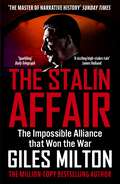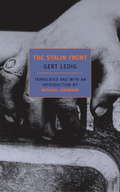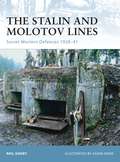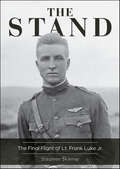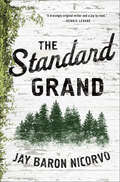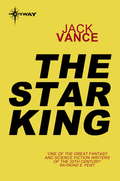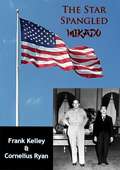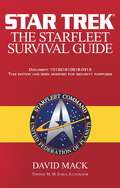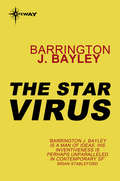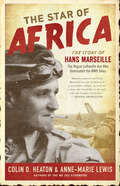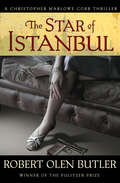- Table View
- List View
The Stalin Affair: The Impossible Alliance that Won the War
by Giles Milton'Page-turning . . . a sizzling high-stakes tale' JAMES HOLLAND'This book might read like the screenplay of a gripping movie, yet every word is accurate and verified' ANDREW ROBERTS 'Giles Milton is a phenomenon' DAN SNOW'Another rollercoaster ride from Giles Milton. Endlessly surprising' ANTHONY HOROWITZFrom internationally bestselling historian Giles Milton comes the remarkable true story of the Allies' secret mission to wartime Moscow. In the summer of 1941, as Hitler invaded the Soviet Union, Stalin's forces faced a catastrophic defeat which would make the Allies' liberation of Europe virtually impossible. To avert this disaster, Britain and America mobilized an elite team of remarkable diplomats with the mission of keeping the Red Army in the war. Into to the heart of Stalin's Moscow Roosevelt sent Averell Harriman, the fourth richest man in America and his brilliant young daughter Kathy. Churchill dispatched the reckless but brilliant bon vivant Archie Clark Kerr - and occasionally himself - to negotiate with the Kremlin's wiliest operators. Together, this improbable group grappled with the ingenious, mercurial Stalin to make victory possible. But they also discovered that the Soviet dictator had a terrifying masterplan for the post-war world. Based on astonishing unpublished diaries, letters and secret reports, The Stalin Affair reveals troves of new material about the most unlikely coalition in history.
The Stalin Affair: The Impossible Alliance that Won the War
by Giles Milton'Page-turning . . . a sizzling high-stakes tale' JAMES HOLLAND'This book might read like the screenplay of a gripping movie, yet every word is accurate and verified' ANDREW ROBERTS 'Giles Milton is a phenomenon' DAN SNOW'Another rollercoaster ride from Giles Milton. Endlessly surprising' ANTHONY HOROWITZFrom internationally bestselling historian Giles Milton comes the remarkable true story of the Allies' secret mission to wartime Moscow. In the summer of 1941, as Hitler invaded the Soviet Union, Stalin's forces faced a catastrophic defeat which would make the Allies' liberation of Europe virtually impossible. To avert this disaster, Britain and America mobilized an elite team of remarkable diplomats with the mission of keeping the Red Army in the war. Into to the heart of Stalin's Moscow Roosevelt sent Averell Harriman, the fourth richest man in America and his brilliant young daughter Kathy. Churchill dispatched the reckless but brilliant bon vivant Archie Clark Kerr - and occasionally himself - to negotiate with the Kremlin's wiliest operators. Together, this improbable group grappled with the ingenious, mercurial Stalin to make victory possible. But they also discovered that the Soviet dictator had a terrifying masterplan for the post-war world. Based on astonishing unpublished diaries, letters and secret reports, The Stalin Affair reveals troves of new material about the most unlikely coalition in history.
The Stalin Front
by Michael Hofmann Gert Ledig1942, at the Eastern Front. Soldiers crouch in horrible holes in the ground, mingling with corpses. Tunneled beneath a radio mast, German soldiers await the order to blow themselves up. Russian tanks, struggling to break through enemy lines, bog down in a swamp, while a German runner, bearing messages from headquarters to the front, scrambles desperately from shelter to shelter as he tries to avoid getting caught in the action. Through it all, Russian artillery—the crude but devastatingly effective multiple rocket launcher known to the Germans as the Stalin Organ and to the Russians as Katyusha—rains death upon the struggling troops. Comparable to such masterpieces of war literature as Ernst Jünger's Storm of Steel and Erich Remarque's All Quiet on the Western Front, The Stalin Front is a harrowing, almost photographic, description of violence and devastation, one that brings home the unforgiving reality of total war.
The Stalin and Molotov Lines
by Adam Hook Neil ShortDuring the Russian Civil War, the Red Army created a series of fortified areas, or ukreplinnyje rajony (UR), which were to be used not only for defence but were also to act as staging points for offensive operations. Following the end of the war these defences were extended, creating a front that stretched over 2,000km from the Baltic to the Black Sea, that consisted of more than 3,000 positions from forts to machine gun and antitank positions, emplaced tank turrets, and observation and command positions. By the outbreak of World War II, these defenses - known as the Stalin Line - were largely complete. However, after the Soviet occupation of eastern Poland in October 1939 the Stalin Line was too far behind the new border to be of use as a springboard for an offensive. So, a new set of defenses was begun, named after the Soviet Foreign Minister, Molotov. Equipment was stripped from the Stalin Line, but only 25 percent of the positions had been completed by the time of the German invasion in June 1941 and it proved no match for the Wehrmacht - positions were mostly empty or simply bypassed during the advance. Illustrated with cutaway artwork and rare photographs this book provides a detailed examination of the development of these defensive lines, and the fighting that took place around them in 1941, and is packed with detail and information that is not readily available in the English.
The Stand: The Final Flight of Lt. Frank Luke Jr.
by Stephen SkinnerA revised and expanded new edition of this classic biography of a legendary American fighter pilot. Frank Luke was the first American airman to be awarded the Medal of Honor. He was the second-highest-scoring American fighter ace of the First World War, just behind Eddie Rickenbacker. Unlike the jovial Rickenbacker, Luke is an enigma. On the basis of his unmatched rate of aerial victories, including many heavily defended balloons, Luke was likely one of the bravest and most gifted fighter pilots of the war. On the other hand, the young Arizonan was almost universally disliked and doubted by his peers. Frank Luke was shot down and killed on September 29, 1918; he was 21 years old and had been in combat for just over a month. The details of this exceptional pilot's death were murky, heavily shrouded by rumor and mythos. Author Stephen Skinner changed that. Skinner immersed himself in the life and death of Frank Luke. Fifteen years of research, including archeological digs, dozens of interviews, nine trips to France, and the review of 2,000 pages of unpublished archival material, produced the definitive work on a truly legendary figure in US military history. This new edition combines new content and revisions with a refreshed presentation and format.
The Standard Grand: A Novel
by Jay Baron Nicorvo**One of the BrooklynRail's Best Books of 2017**"Nicorvo is a bracingly original writer and a joy to read." —Dennis Lehane"A desperate masterpiece of a debut" that tells a huge-hearted American saga—of love, violence, war, conspiracy and the aftermath of them all." —Bonnie Jo Campbell"Nicorvo’s muscular and energetic prose will stun readers with its poignancy, while providing a punch to the solar plexus." —Booklist (Starred Review)"A dash of Coetzee, a dram of Delillo, but mostly just the complicated compassion of Jay Nicorvo. The Standard Grand is a brutally beautiful novel." —Pam Houston, author of Contents May Have Shifted"It seems possible that Nicorvo has ingested all the darkness of this life and now breathes fire.” Nick Flynn, author of Another Bullshit Night in Suck CityWhen an Army trucker goes AWOL before her third deployment, she ends up sleeping in Central Park. There, she meets a Vietnam vet and widower who inherited a tumbledown Borscht Belt resort. Converted into a halfway house for homeless veterans, the Standard—and its two thousand acres over the Marcellus Shale Formation—is coveted by a Houston-based multinational company. Toward what end, only a corporate executive knows.With three violent acts at its center—a mauling, a shooting, a mysterious death decades in the past—and set largely in the Catskills, The Standard Grand spans an epic year in the lives of its diverse cast: a female veteran protagonist, a Mesoamerican lesbian landman, a mercenary security contractor keeping secrets and seeking answers, a conspiratorial gang of combat vets fighting to get peaceably by, and a cougar—along with appearances by Sammy Davis, Jr. and Senator Al Franken. All of the characters—soldiers, civilians—struggle to discover that what matters most is not that they’ve caused no harm, but how they make amends for the harm they’ve caused.Jay Baron Nicorvo's The Standard Grand confronts a glaring cultural omission: the absence of women in our war stories. Like the best of its characters—who aspire more to goodness than greatness—this American novel hopes to darn a hole or two in the frayed national fabric.
The Star Fox
by Poul AndersonEarthmen and Aleriona have met in space and neither side can afford to let the other get too strong. The Aleriona have captured the human outpost, New Europe, and claim that all the inhabitants were killed. The World Federation on Earth seems committed to peace at any price, but there are those, and ex-navy Captain Gunnar Heim is one of them, who know that appeasement will only lead to further Alerion encroachment, and he passionately believes that there must be a showdown now, before it is too late.Heim and his crew of volunteers take off from Earth in the Star Fox and start to fit out for their hit-and-run battle.
The Star Fraction: Book One: The Fall Revolution Series (Fall Revolution Ser. #1)
by Ken MacLeod'He is writing revolutionary science fiction. A nova has appeared in our sky.' - Kim Stanley Robinson'Engaged, ingenious, and wittily partisan, Ken MacLeod is a one-man revolution, SF's Billy Bragg' - ASIMOV'S SFIn a newer world order where the peace process is deadlier than the wars ...Moh Kohn is a security mercenary with a smart gun, reflexes to die for and memories he doesn't want to reach.Jamis Taine is a scientist with a new line in memory drugs, anti-tech terrorists on her case and the STASIS cops on her trail.Jordan Brown is a teenage atheist with a guilty conscience, a wad of illicit cash and an urgent need to get a life.Between them they've started the countdown to the final confrontation, as the cryptic Star Fraction assembles its codes, the Army of the New Republic prepares its offensive and Space Defence lines up its laser weapons for the hour of the Watchmaker ...The debut novel from a major force in SF, the first of his novels to be shortlisted for the Arthur C. Clarke Award.Books by Ken MacLeod:Fall RevolutionThe Star FractionThe Stone CanalThe Cassini DivisionThe Sky RoadEngines of LightCosmonaut KeepDark LightEngine CityCorporation Wars TrilogyDissidenceInsurgenceEmergenceNovelsThe Human FrontNewton's WakeLearning the WorldThe Execution ChannelThe Restoration GameIntrusionDescent
The Star Fraction: Book One: The Fall Revolution Series (Fall Revolutions #1)
by Ken MacLeod'He is writing revolutionary science fiction. A nova has appeared in our sky.' - Kim Stanley Robinson'Engaged, ingenious, and wittily partisan, Ken MacLeod is a one-man revolution, SF's Billy Bragg' - ASIMOV'S SFIn a newer world order where the peace process is deadlier than the wars ...Moh Kohn is a security mercenary with a smart gun, reflexes to die for and memories he doesn't want to reach.Jamis Taine is a scientist with a new line in memory drugs, anti-tech terrorists on her case and the STASIS cops on her trail.Jordan Brown is a teenage atheist with a guilty conscience, a wad of illicit cash and an urgent need to get a life.Between them they've started the countdown to the final confrontation, as the cryptic Star Fraction assembles its codes, the Army of the New Republic prepares its offensive and Space Defence lines up its laser weapons for the hour of the Watchmaker ...The debut novel from a major force in SF, the first of his novels to be shortlisted for the Arthur C. Clarke Award.Books by Ken MacLeod:Fall RevolutionThe Star FractionThe Stone CanalThe Cassini DivisionThe Sky RoadEngines of LightCosmonaut KeepDark LightEngine CityCorporation Wars TrilogyDissidenceInsurgenceEmergenceNovelsThe Human FrontNewton's WakeLearning the WorldThe Execution ChannelThe Restoration GameIntrusionDescent
The Star King
by Jack VanceThe first book in the 5 volume Demon Princes saga. The protagonists parents were murdered by a posse of 5 galactic criminals, the "demon princes". He vows revenge, and eliminates them one by one. In the process Vance does what he excels at: creating strange worlds, environments, customs, and adaptations that humans have made to live in these conditions.
The Star Spangled Mikado
by Cornelius Ryan Frank KelleyTwo correspondents in Tokyo describe, breezily and none too reverently, various phases of the American occupation of Japan, including MacArthur's efforts to lay a basis for democratic government. They do not impugn the General's motives, but they feel that he is relying on the very people who backstopped Japanese expansionism before and are preparing to do it again.
The Star Trek: Revised Edition (Star Trek: The Next Generation)
by Larry NemecekWith the release of the hit feature Star Trek: Nemesis this is the perfect opportunity to update this book with all of the Star movies featuring The Next Generation cast!Here is the complete official guide to every episode of the television adventures of the Starship Enterprise and all four of the major motion pictures from Star Trek Generations to latest Star Trek: Nemesis. This companion is a compendium of information including plot summaries and credits for each show and motion picture, as well as fascinating behind-the-scenes glimpses into creation of The Next Generation. Take a glimpse into the shows incredible seven-year run where it reigned at the very top of the syndicated television ratings. Illustrated with more than 150 black and white photographs, this is the official reference guide to Star Trek: The Next Generation.
The Star Trek: Star Trek All Series (Star Trek)
by David MackAs the brave men and women of Starfleet carry out their duties -- mapping countless solar systems, greeting new species and establishing ties with civilizations large and small -- they live, work, and face the possibility that they could die in space. How do Starfleet's finest survive the countless dangers to be discovered as they boldly go where no one has gone before? Find out with this special edition of The Starfleet Survival Guide! Contains up tp date, declassified information on STANDARD EQUIPMENT -- NONSTANDARD USES UNCONVENTIONAL MEDICINE DANGEROUS LIFE-FORMS EXTREME SCENARIOS And more! For further reference, or if you are considering and exciting and fulfilling career in the diplomatic and scientific fleet of the United Federation of Planets, please contact your local Starfleet representative.
The Star Trek: The Case of the Colonist's Corpse
by Bob Ingersoll Tony IsabellaWhen Captain Kirk faced court-martial, he chose the best lawyer in the Federation -- Samuel T. Cogley, a cranky old man who prefers books to padds and people to computers. Now, once again, it's SAM COGLEY FOR THE DEFENSE! The planet Aneher II sits in the middle of the Neutral Zone, and neither the Klingon™ Empire nor the Federation can claim it. Under the terms of the Organian Peace Treaty, any such contested colony world will go to the party -- Federation or Klingon -- which shows it can best develop the planet. At first the two colonies live in peace, but it's a fragile peace, one shattered when Administrator Daniel Latham, the head of the Federation colony, is found murdered, and Commander Mak'Tor, the head of the Klingon colony, is found crouched over Latham's body, discharged phaser still hot in his hand. When Lieutenant Areel Shaw of Starfleet is assigned to prosecute Mak'Tor, Sam Cogley volunteers to defend the accused Klingon. But when Cogley's own investigation provides the prosecution with its key piece of evidence and his courtroom tactics unexpectedly backfire, can even the galaxy's most brilliant defense attorney win the day in... The Case of the Colonist's Corpse
The Star Trek: The Case of the Colonist's Corpse
by Bob Ingersoll Tony IsabellaWhen Captain Kirk faced court-martial, he chose the best lawyer in the Federation -- Samuel T. Cogley, a cranky old man who prefers books to padds and people to computers. Now, once again, it's SAM COGLEY FOR THE DEFENSE! The planet Aneher II sits in the middle of the Neutral Zone, and neither the Klingon™ Empire nor the Federation can claim it. Under the terms of the Organian Peace Treaty, any such contested colony world will go to the party -- Federation or Klingon -- which shows it can best develop the planet. At first the two colonies live in peace, but it's a fragile peace, one shattered when Administrator Daniel Latham, the head of the Federation colony, is found murdered, and Commander Mak'Tor, the head of the Klingon colony, is found crouched over Latham's body, discharged phaser still hot in his hand. When Lieutenant Areel Shaw of Starfleet is assigned to prosecute Mak'Tor, Sam Cogley volunteers to defend the accused Klingon. But when Cogley's own investigation provides the prosecution with its key piece of evidence and his courtroom tactics unexpectedly backfire, can even the galaxy's most brilliant defense attorney win the day in... The Case of the Colonist's Corpse
The Star Trek: The Ferengi Rules of Acquisition (Star Trek: Deep Space Nine)
by Ira Steven BehrThe Ferengi are greedy, avaricious, ruthless, cowardly and completely unscrupulous.For centuries the famous Ferengi Rules of Acquisition have been the guiding principles of the galaxy's most successful entrepreneurs. These 285 Rules of Acquisition range from, #1 "Once you have their money, never give it back."to#21 "Never place friendship before profit."These rules and hundreds more have taken many successful Ferengi to new frontiers of profit.
The Star Trek: The Hand of Kahless (Star Trek: The Next Generation)
by Michael Jan Friedman John M. FordThe fiercest battles and proudest warriors throughout Klingon history are said to reflect the honor and glory of the race's first emperor, Kahless the Unforgettable. But history is not always truthful. And for both the Klingon Empire and the United Federation of Planets, the real truth may be too difficult to accept. In the pages of a novel disclaimed by Starfleet, an enemy offers his perspective on events that transpired during the formative years of Klingon-Federation relations in the early twenty-third century. Chronicling the life story of Krenn, a Klingon war strategist who learns of peace while on a mission to Earth, the novel is a testimony to his efforts to preserve the honor of his people...by preventing total war against the then-struggling Federation. Nearly a century later, a clone of the revered Kahless oversees the Klingon Empire. But when the myths and legends associated with the original emperor are disputed following the discovery of an ancient scroll, the new Kahless faces treason from within his own council, and impending civil war that could tear the empire apart. His sole chance for restoring his people's shattered faith must come from the outside -- specifically, from Captain Jean-Luc Picard and Lieutenant Worf of the U.S.S. Enterprise.
The Star Trek: The Rings of Taute (Star Trek: Vanguard #78)
by Dean Wesley SmithAn entire solar system begins to disintegrate into cosmic rubble, and Captain Kirk suspects that rumors of a new Klingon superweapon are all too true. The Tautee system houses a flourishing pre-Warp civilization not quite ready to join the Federation, so the Prime Directive limits Kirk's ability to prevent the disaster, and to make matters worse his rescue efforts provoke an attack from four Klingon warships. But soon Kirk recognizes that he must get to the bottom of the forces at work in the Tautee system, because they could spill over into the rest of the galaxy.
The Star Trek: The Siege (Star Trek: Deep Space Nine #2)
by Peter DavidDeep Space NineTM is forced to curtail entry to the wormhole due to increased graviton emissions, and an air of biting tension settles over the station. This anxiety leads to the murder of an Edeman religious leader, Commander Benjamin Sisko and Security Chief Odo realize they face a larger problem. Soon Sisko and Odo have more lifeless bodies on their hands and a killer who strikes without motive. Then, both the Edemans and Cardassians arrive threatening to destroy the station unless the murderer is given to them for retribution. In order to save Deep Space Nine and stop the killing, Odo must try to destroy a powerful assassin who is the only link to his mysterious past.
The Star Virus
by Barrington J. BayleyWE DEMAND THAT YOU HAND OVER THE OBJECT.Impossible. Ownership is in the hands of our clients.HUMAN OWNERSHIP OF THE OBJECT IS NOT ADMISSIBLE. STREALL CLAIM IS ABSOLUTE. YOU WILL NOTIFY US OF WHEREABOUTS It is already in transit.WE WILL INTERCEPT. NOTIFY.Your claim must be made through the courts.HUMAN COURTS MEAN NOTHING TO THE STREALL. EITHER YOU COMPLY OR TREALL FLEETS WILL OCCUPY YOUR SYSTEM.
The Star of Africa: The Story of Hans Marseille
by Colin D. Heaton Anne-Marie LewisThis WWII military biography chronicles the life of a legendary Nazi fighter pilot.German Luftwaffe Captain Hans-Joachim Marseille, the “Star of Africa”, is a legendary figure in the annals of military history. With 158 kills to his name, he was one of the rare recipients of the Knight’s Cross with Oak Leaves, Swords, and Diamonds, the Third Reich’s highest honor awarded for valor in combat.Unlike other German fighter aces, Marseille is also a famous in the United States and other English-speaking countries. His rebellious nature, iconoclastic behavior, and early death have nourished his reputation just as greatly as his exceptional skill and chivalrous conduct as an adversary.
The Star of Camp Greene: A Novel of WWI
by Joy CallawaySometimes heroism is found in dreams deferred.Charlotte, NC. 1918. Broadway darling Calla Connolly had it all: a rising career on the stage and a loving fiancé, a fellow stage actor. But after his tragic death early in the war, Calla is touring the American training camps, hoping to convince General Pershing to let her tour the French front to cheer the men and honor her fiancé's memory. But her hopes are dashed when she contracts Spanish flu while performing at Camp Greene.While convalescing, Calla inadvertently overhears a sensitive Army secret and is ordered to remain at Camp Greene for the duration of the war while her former mentor and rival steals her tour out from under her. Having no choice but to stay at the camp, she becomes the resident performer and forms attachments to several musician soldiers.When she falls in love with the man responsible for trapping her at camp, the mission she's sworn to keep secret threatens the men she's come to care for. Calla is forced to decide what her dreams are worth--and if the future she never expected might only be possible if she lets those dreams go.
The Star of Istanbul: A Christopher Marlowe Cobb Thriller (The Christopher Marlowe Cobb Thrillers #2)
by Robert Olen ButlerAn intrepid reporter boards the Lusitania in a &“vivid . . . ripping good&” spy thriller from the Pulitzer Prize–winning author (The Wall Street Journal). It&’s 1915, World War I is in full swing, and foreign correspondent Christopher &“Kit&” Marlowe Cobb is tasked with following a German intellectual and possible secret service agent who&’s just boarded the British ocean liner Lusitania. But Cobb is soon distracted from his mission by the sultry Selene Bourgani, a world-renowned silent film star who also appears to be working with German Intelligence. The secrets Selene harbors have the potential to set the whole international conflict further aflame—and they&’re about to be ignited by a German U-boat attack off the Irish coast. From the perilous waters of the Atlantic, Cobb tails Selene into London&’s darkest alleyways, then on to the powder keg that is Istanbul. Across the war-torn stages of Europe and the Middle East, Cobb must venture deep behind enemy lines, knowing full well he may not return. The second book in the Christopher Marlowe Cobb Thrillers, The Star of Istanbul &“has it all: history galore, exotic foreign settings, a world-weary yet engaging protagonist, villains in abundance and a romance worthy of Bogart and Bergman&” (BookPage). &“[An] outstanding work of historical fiction.&” —The Huntington News &“Butler . . . holds the reader transfixed, like a kid at a Saturday matinee.&” —Booklist, starred review &“An exciting thriller with plenty of action, romance, and danger . . . [a] fast-paced journey through a world at war.&” —Library Journal
The Star of Life
by Edmond HamiltonKirk Hammond was a man alone. He had been chosen to ride in the first manned satellite to go out around the Moon and back to Earth. But when the satellite failed to orbit properly, it went on past the Moon into the vastness of outer space, and a whole world watched helplessly as he was borne toward an unthinkably lonely death. Yet destiny decreed that Kirk Hammond should suffer, not death but a pseudo-death. And he awoke from it to find that a hundred centuries had passed and that the space age which had begun in the 20th Century had now grown into a vast galactic civilization that had carried the sons of Earth to countless stars and worlds. But, unexpectedly, the conquest of space had changed Man himself, and the human race had become not one but several species. Hammond was plunged into the climactic struggle between the new races. And in his quest with a desperate band for the mysterious Star of Life that was the key to the struggle, in his relations with the strange and beautiful Thayn Marden who was not a human woman, in his odyssey through the mighty suns and earthly worlds of the galaxy, a man of the 20th Century found himself facing the dangers of the great space age which he himself helped pioneer.
